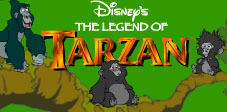
The Legend of Tarzan is an American animated television series produced by Walt Disney Television Animation, based on Tarzan from the novels written by Edgar Rice Burroughs, the character's original creator who appears in one episode of the series. The series is also based on Disney's 1999 animated feature film Tarzan by Walt Disney Pictures and aired initially on the Disney's One Too block on UPN. However, reruns were broadcast shortly after on Toon Disney.
Opar is a fictional lost city in the Tarzan novels of Edgar Rice Burroughs and later the Khokarsa novels of Philip José Farmer and Christopher Paul Carey, as well as various derivative works in other media.
Mangani is the name of a fictional species of great apes in the Tarzan novels of Edgar Rice Burroughs, and of the invented language used by these apes. In the invented language, Mangani is the apes' word for their own kind, although the term is also applied to humans. The Mangani are represented as the apes who foster and raise Tarzan.

Jane Porter is a fictional character in Edgar Rice Burroughs's series of Tarzan novels and in adaptations of the saga to other media, particularly film. Jane, an American from Baltimore, Maryland, is the daughter of professor Archimedes Q. Porter. She becomes the love interest, later the wife of Tarzan and subsequently the mother of their son, Korak. She develops over the course of the series from a conventional damsel in distress, who must be rescued from various perils, to an educated, competent and capable adventuress in her own right, fully capable of defending herself and surviving on her own in the jungles of Africa.

Tarzan the Untamed is a book by American writer Edgar Rice Burroughs, the seventh in his series of twenty-four books about the title character Tarzan. It was originally published as two separate stories serialized in different pulp magazines; "Tarzan the Untamed" in Redbook from March to August, 1919, and "Tarzan and the Valley of Luna" in All-Story Weekly from March to April 1920. The two stories were combined under the title of the first in the first book edition, published in 1920 by A. C. McClurg. In order of writing, the book follows Jungle Tales of Tarzan, a collection of short stories about the ape-man's youth. Chronologically, it follows Tarzan and the Jewels of Opar.

Hadon of Ancient Opar is a fantasy novel by American writer Philip José Farmer, first published in paperback by DAW Books in April 1974, and reprinted three times through 1983. The first British edition was published by Magnum in 1977; it was reprinted by Methuen in 1993. The first trade paperback edition was published by Titan Books in 2013. The work has also been translated into French. It was later gathered together with its sequels Flight to Opar and The Song of Kwasin into the omnibus collection Gods of Opar: Tales of Lost Khokarsa (2012). It and its sequels purport to fill in some of the ancient prehistory of the lost city of Opar, created by Edgar Rice Burroughs as a setting for his Tarzan series.

The Return of Tarzan is a novel by American writer Edgar Rice Burroughs, the second in his series of twenty-four books about the title character Tarzan. The story was first published in the pulp magazine New Story Magazine in the issues for June through December 1913; the first book edition was published in 1915 by A. C. McClurg.

Tarzan and the Ant Men is a novel by American writer Edgar Rice Burroughs, the tenth in his series of twenty-four books about the jungle hero Tarzan. It was first published as a seven-part serial in the magazine Argosy All-Story Weekly for February 2, 9, 16 and 23 and March 1, 8 and 15, 1924. The story was first published in book form in hardcover by A. C. McClurg in September 1924. It was also adapted for Gold Key Comics in Tarzan #174-175 (1968).

Tarzan and the Jewels of Opar is a novel by American writer Edgar Rice Burroughs, the fifth in his series of twenty-four books about the title character Tarzan. The story first appeared in the November and December issues of All-Story Cavalier Weekly in 1916, and the first book publication was by McClurg in 1918.
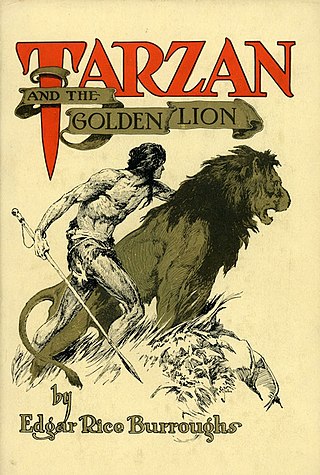
Tarzan and the Golden Lion is an adventure novel by American writer Edgar Rice Burroughs, the ninth in his series of twenty-four books about the title character Tarzan. The story was first published as a seven part serial in Argosy All-Story Weekly beginning in December 1922; and then as a complete novel by A.C. McClurg & Co. on March 24, 1923.
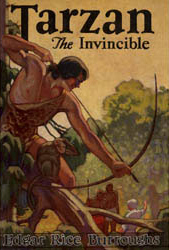
Tarzan the Invincible is a novel by American writer Edgar Rice Burroughs, the fourteenth in his series of twenty-four books about the title character Tarzan. The novel was originally serialized in the magazine Blue Book from October, 1930 through April, 1931 as Tarzan, Guard of the Jungle.
Muviro, chief of the Waziri, is a character in the Tarzan saga created by Edgar Rice Burroughs.
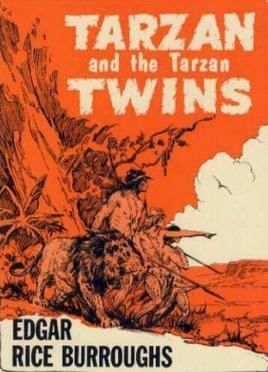
Tarzan and the Tarzan Twins is a collection of two Tarzan novellas by American writer Edgar Rice Burroughs, for younger readers. It was originally published as two children's books, The Tarzan Twins by Voland in October 1927, and Tarzan and the Tarzan Twins, with Jad-bal-ja, the Golden Lion, by Whitman in March 1936. These were brought together in November 1963 under the title of Tarzan and the Tarzan Twins in the first complete edition.

Tarzan the Tiger (1929) is a Universal movie serial based on the novel Tarzan and the Jewels of Opar by Edgar Rice Burroughs. It stars Frank Merrill as Tarzan, Natalie Kingston as Jane, and Al Ferguson. It was directed by Henry MacRae.

The Adventures of Tarzan (1921) is a 15 chapter movie serial which features the third and final appearance of Elmo Lincoln as Tarzan. The serial was produced by Louis Weiss, written by Robert F. Hill and Lillian Valentine, and directed by Robert F. Hill and Scott Sidney. The first chapter was released on December 1, 1921.

Tarzan and the Lost Safari is a 1957 action adventure film featuring Edgar Rice Burroughs' famous jungle hero Tarzan and starring Gordon Scott, Robert Beatty, Yolande Donlan and Betta St. John. Directed by H. Bruce Humberstone, it was the first Tarzan film released in color, Eastman Color. The nineteenth film of the Tarzan film series that began with 1932's Tarzan the Ape Man and the first produced by MGM since 1942, it was filmed in Nairobi, British East Africa. The character of Jane does not appear in this motion picture. Released April 12, 1957, it was followed by Tarzan and the Trappers in 1958.

Nkima is a fictional character in Edgar Rice Burroughs' Tarzan novels, and in adaptations of the saga to other media, particularly comics. His name comes from either the word N'kima, or, after the Meru language nickname for Ugali, a dish popular in Kenya and Tanzania made from maize flour.

Tarzan is a fictional character, a feral child raised in the African jungle by the Mangani great apes; he later experiences civilization, only to reject it and return to the wild as a heroic adventurer.
The Waziri are a fictional African tribe created by Edgar Rice Burroughs in his Tarzan novels. Burroughs characterizes the Waziri as the greatest warriors in Africa, though small in numbers. They are feared by Arabic ivory and slave traders as well as cannibal tribes, and known from western to eastern Africa. The Waziri also appear in other media based on the novels.
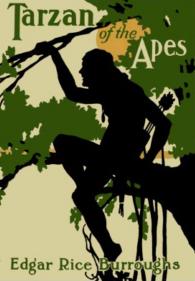
Tarzan is a series of 24 adventure novels written by Edgar Rice Burroughs (1875–1950) and published between 1912 and 1966, followed by several novels either co-written by Burroughs, or officially authorized by his estate. There are also two works written by Burroughs especially for children that are not considered part of the main series.

















